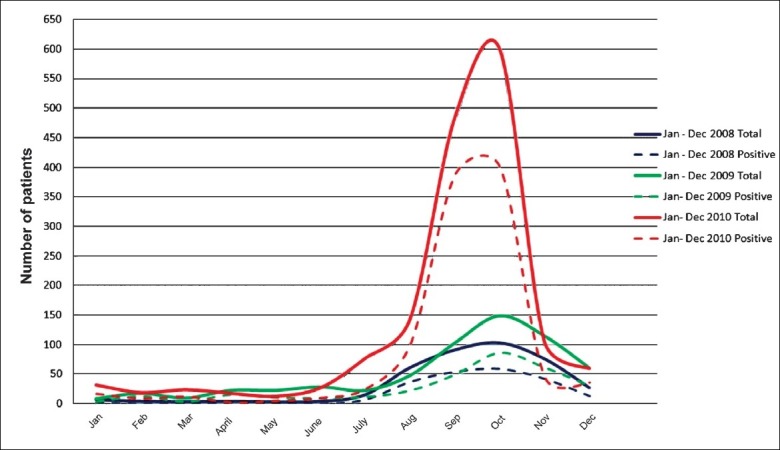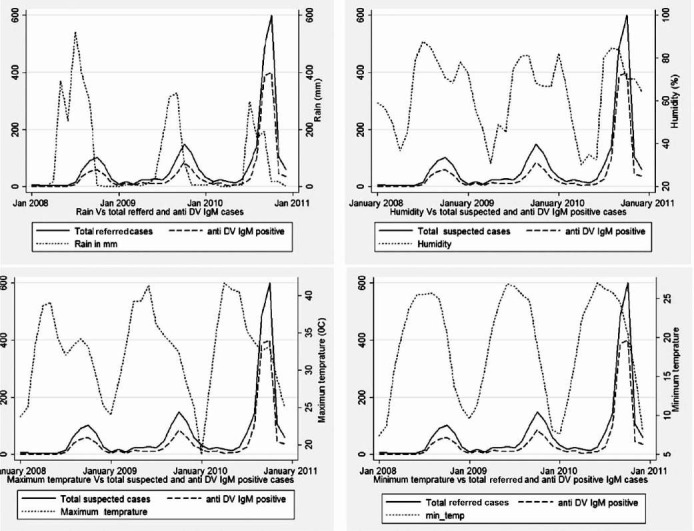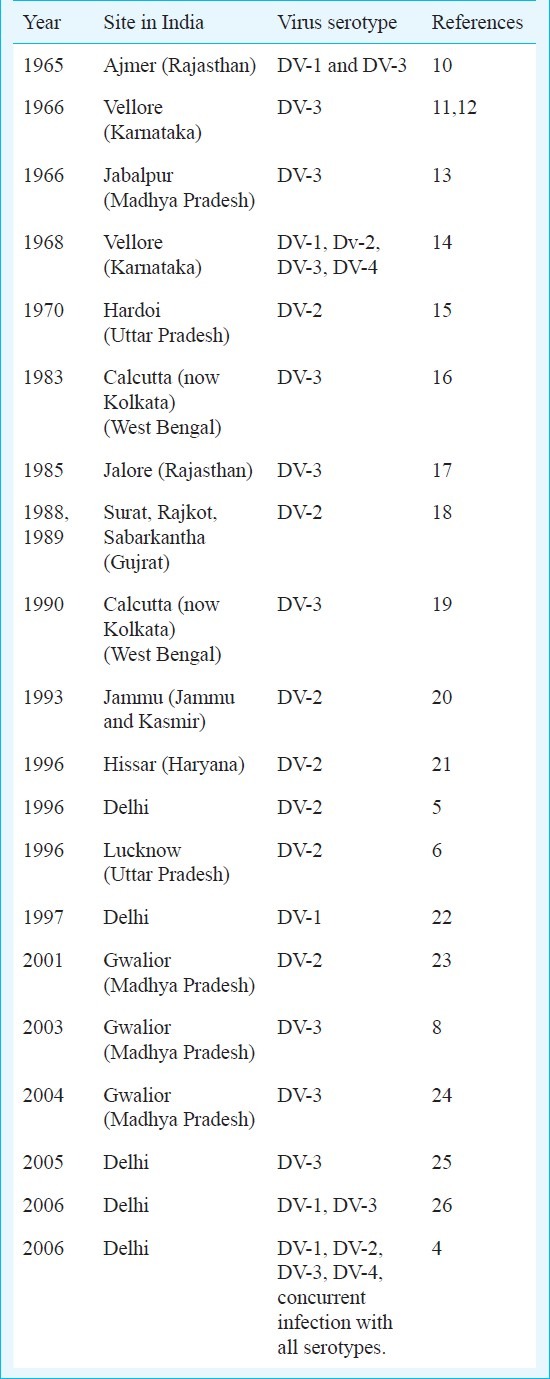Abstract
Background & objectives:
Dengue virus (DV) infection has emerged as a major health problem in north India. Here, we report the annual trend of dengue virus infection as seen in Lucknow, Uttar Pradesh, during 2008-2010.
Methods:
Blood samples from clinically suspected cases of dengue virus infection were collected and history was taken on structured clinical data sheet. All samples were tested for dengue IgM by antibody capture ELISA. Selected samples were tested by conventional RT-PCR for dengue virus RNA. Weather information was continuously recorded from website of world weather information service.
Results:
There was a gradual increase in number of dengue fever cases with increased occurrence in 2010. Cases referred in January - December 2008 were 398 (54.5% anti DV IgM positive), in January - December 2009 were 599 (51.9% anti DV IgM positive) and in January - December 2010 were 1602 (64.9% anti DV IgM positive). Serotypes circulating in years 2008, 2009 and 2010 were DV-2 & DV-3, DV -1, 2 & 3 and DV-1 and DV-2 respectively. There is no statistical significant correlation between weather data and increasing dengue positive cases.
Interpretation & conclusions:
Increased cases of dengue fever were seen in 2010, which was not correlated with any change in environmental factors. A change in circulating serotypes was noted.
Keywords: Annual trend, dengue virus infection, epidemic, outbreak, seasonality
Dengue fever (DF) has emerged as one of the world's major infectious diseases. Epidemics of dengue fever were first reported from the coastal area of Africa and later from Malaysia in the 19th century1. The infection is by now seen as a global epidemic with recorded prevalence in more than 120 countries2. Dengue is transmitted by Aedes mosquitoes, particularly Aedes aegyptii and, less important, Ae. albopictus. During the last 200 years, spread of the disease has increased, reaching endemic proportions during the last three decades2.
In India, the first virologically confirmed epidemic occurred in Calcutta (now Kolkata) and the eastern coast of India in 1963-19643. According to published reports all four serotypes of the virus are co-circulating in India4. A major widespread epidemic of dengue haemorrhagic fever (DHF) occurred in 1996 involving areas around Delhi and Lucknow5,6, since then, there has been a remarkable resurgence of the infection in north Indian plains that include the State of Uttar Pradesh. Once considered an urban problem, it has now penetrated into rural areas as well, due to high population density and other factors7. The illness occurs throughout the year with a peak during monsoon and post-monsoon season due to high vector density. Major outbreaks have occurred in north India8. Here we report the annual trend of dengue virus infection as seen in Lucknow, Uttar Pradesh, India, during the three years 2008-2010.
Material & Methods
Study area: Lucknow is situated at 26.75° latitude, 88.88° longitudes and 128 meter altitude in heart of Gangatic plain, has population of 2,750,447 and population density of 2011 person/km2 (http://www.lucknow.nic.in). Climate is humid subtropical with cool dry winter from December to February and dry hot summer from April to June. The rainy season is from mid June to mid September. Average rainfall is 101 mm mostly from south west monsoon. Weather data were obtained from the website of world weather information service (http://world wealther.wmo.int/).
Laboratory methods: This study was conducted in the Department of Microbiology, King George Medical University (KGMU), Lucknow, over a period of 3 yr from 2008 to 2010. The hospital has total 2424 beds in different departments. Annually about 5,10000 patients visit outpatient department (OPD) and 51,000 patients get indoor admission. Data from patients with suspected diagnosis of dengue virus infection, referred to us for laboratory confirmation, since January 2008 to December 2010, were analyzed. No intervention was done for the present study. The study protocol was approved by the institutional ethics committee and informed consent for using the patient sample and data was taken. Blood samples (5 ml) were collected and tested for anti DV IgM. Remaining sample was stored at -80°C. Dengue virus specific IgM was tested by antibody capture ELISA (Mac ELISA) using commercial kits (Panbio, Australia). A detailed clinical history of all the cases was taken using a structured clinical data sheet.
Samples stored at -80° C, >500 μl in volume and from patients having illness less than 7 days, were selected. These samples were tested by nested RT-PCR for serotype specific DV RNA. RNA was extracted from 250 μl serum samples by using Tri reagent [Sigma-Aldrich, USA] according to manufacturer's instructions. The identification was carried out by RT-PCR followed by nested PCR by demonstrating the presence of virus specific RNA employing dengue group-specific as well as serotype-specific primers targeting C-prM gene junction following the protocol of Lanciotti et al9. Negative (double distilled water)and positive controls (dengue virus culture fluid) were included at all the steps. Correlation between weather data and positive dengue cases was drawn using STATA 11 software (Texas, USA). Annual pattern of dengue infection was calculated by taking month-wise ratio of different variables in each year.
Results
A total of 398 cases were referred for diagnosis of dengue fever during January - December 2008, of which 217 (54.5 %) were anti DV IgM positive, during January - December 2009 there were 599 cases, of which 311 (51.9 %) were anti DV IgM positive, and during January - December 2010 there were 1602 cases, of which 1039 (64.9%) were positive for anti DV IgM antibody. Month-wise distribution of cases is given in Fig. 1. Age-wise distribution of total referred cases and anti DV IgM positive cases is shown in Table I. Paediatric references were more than adults, but in 2010 along with paediatric population adult references were also very high. Positivity rate among age groups was similar throughout the study (Table I). Male references were more than females, a usual trend seen in our total hospital admissions during study (data not shown).
Fig. 1.

Month-wise distribution of total suspected and anti DV positive cases in different years.
Table I.
Age-wise distribution of total referred and anti DV IgM positive cases

Cases of dengue fever started increasing in the last week of June or early July every year and reached at peak during August to October (Fig. 1). Rainy season in Lucknow starts around late June and lasts till October. A seasonal peak of DV infection was recorded around 4-6 wk after arrival of rain every year. There was no strong statistical evidence of increase in anti DV IgM positive cases in 2010, with change in maximum temperature (R= 0.0135, P=0.937), minimum temperature (R=0.1550, P=0.3668), humidity (R= 0.3077, P=0.0679) and amount of rain fall (R=0.0431, P=0.8029) (Fig. 2).
Fig. 2.

Correlation of rain fall, humidity, maximum temperature, minimum temperature, with total referred dengure cases and anti DV IgM positive cases.
Selected serum samples were tested for detection of DV RNA. In 2008 only 42 samples were tested and DV-2 and DV-3 serotypes were detected in 10 and 8 samples, respectively. In 2009, a total of 69 samples were tested and DV-1 was detected in 5 samples, DV-2 in 20 samples, and DV-3 in 15 samples. In 2010, of the 80 serum samples tested, DV-1 was detected in 16 samples and DV-2 was detected in 4 samples. DV-4 was not detected throughout.
Discussion
During 2008-2010, an increasing number of dengue virus infection cases was observed, reaching an epidemic proportion in 2010, with change in circulating serotype. Dengue fever is an ancient disease. Dengue has emerged as a major health problem in north Indian region. The epidemiology of dengue virus and its prevalent serotypes keep on changing. In India, different circulating serotypes have been reported during different outbreaks (Table II). In 2006 all the four serotypes were co-circulating in north Indian plains. DV-2 and DV-3 were the dominant serotypes during 2008-2009, which were also circulating in previous years. In 2009, DV-1 appeared and in 2010 it became the dominant serotype.
Table II.
Epidemiology of dengue circulating serotype in India

Rain, temperature and relative humidity are reported as the major and important climatic factors, which could alone or collectively be responsible for an epidemic. In north India, the largest proportion of serologically positive cases have been recorded in the post-monsoon period27. Our findings were similar to those reported by other groups from this geographical region4,5. In a study done in Bangladesh, the seasonal occurrence of positive cases has shown that post-monsoon period is the most affected period28. Studies have proposed that ecological and climatic factors influence the seasonal prevalence of the vector Ae. aegypti and dengue virus29. The vector has adapted to extremes of warm and cold weather resulting in occurrence of dengue cases round the year. Dengue virus and the vector have been reported in the arid zones of Rajasthan as well17.
In 2008 and 2009 the highest number of cases that were positive for anti DV IgM were from paediatrics population. In 2010, a shift was seen toward higher age group. In Asian countries where dengue has been epidemic for several years, this age shift is clearly observed, indicating an epidemiological change in dengue infection30.
This is a hospital based study and may not represent the true community picture as only highly suspected or confirmed cases are reported here. Increase in awareness, better diagnostic facilities, availability of more sensitive and specific diagnostic tests can influence reporting pattern to some extent.
In conclusion, an increase in DF cases was seen in 2010 compared to previous two years, and this increase was not related to changes in environmental factors. DV-1 was found to be the dominant serotype in 2010. Contentious efforts for long term laboratory based surveillance systems should be made that can forecast dengue epidemics. This will help alert the public and physicians to diagnose and properly treat DF/DHF cases.
Acknowledgment
Authors acknowledge the Indian Council of Medical Research (ICMR), New Delhi, for providing financial support.
References
- 1.Smith CEG. The history of dengue in tropical Asia and its probable relationship to the mosquito Aedes aegypti. Trop Med Hyg. 1956;59:243–51. [PubMed] [Google Scholar]
- 2.Halstead SB. Dengue. Lancet. 2007;370:1644–52. doi: 10.1016/S0140-6736(07)61687-0. [DOI] [PubMed] [Google Scholar]
- 3.Ramakrishanan SP, Gelfand HM, Bose PN, Sehgal PN, Mukharjee RN. The epidemic of acute haemorrhagic fever, Calcutta, 1963: epidemiological Inquiry. Indian J Med Res. 1964;52:633–50. [PubMed] [Google Scholar]
- 4.Bharaj P, Chaher HS, Pandey A, Diddi K, Lalit D, Guleria R, et al. Concurrent infections by all four dengue virus serotypes during an outbreak of dengue in 2006 in Delhi, India. Virol J. 2008;5:1–4. doi: 10.1186/1743-422X-5-1. [DOI] [PMC free article] [PubMed] [Google Scholar]
- 5.Dar L, Broor S, Sengupta S, Xess I, Seth P. The first major outbreak of dengue hemorrhagic fever in Delhi, India. Emerg Infect Dis. 1999;5:589–90. doi: 10.3201/eid0504.990427. [DOI] [PMC free article] [PubMed] [Google Scholar]
- 6.Agarwal R, Kapoor S, Nagar R, Misra A, Tandon R, Mathur A, et al. Clinical study of the patients with dengue haemorrhgic fever during the epidemic of 1996 at Lucknow, India. Southeast Asian J Trop Med Public Health. 1999;30:735–40. [PubMed] [Google Scholar]
- 7.Tripathi P, Kumar R, Tripathi S, Tambe JJ, Venktesh V. Descriptive epidemiology of dengue transmission in Uttar Pradesh. Indian Paediatr. 2008;45:315–8. [PubMed] [Google Scholar]
- 8.Dash PK, Saxena P, Abhyankar A, Bhargava R, Jana AM. Emergence of dengue virus type-3 in northern India. Southeast Asian J Trop Med Public Health. 2005;36:370–7. [PubMed] [Google Scholar]
- 9.Lanciotti RS, Calisher C, Gubler DJ, Chang G, Vorndam V. Rapid detection and typing of Dengue Viruses from clinical samples by using Reverse Transcriptase Polymerase Chain Reaction. J Clin Virol. 1992;30:545–55. doi: 10.1128/jcm.30.3.545-551.1992. [DOI] [PMC free article] [PubMed] [Google Scholar]
- 10.Ghosh SN, Pavri KM, Singh KR, Sheikh BH, D’lima LV, Mahadev PV, et al. Investigations on the outbreak of dengue fever in Ajmer City, Rajasthan State in 1969. Part I. Epidemiological, clinical and virological study of the epidemic. Indian J Med Res. 1974;62:511–22. [PubMed] [Google Scholar]
- 11.Myers RM, Carey DE, Banerjee K, Reuben R, Ramamurti DV. Recovery of dengue type 3 virus from human serum and Aedes aegypti in South India. Indian J Med Res. 1968;56:781–7. [PubMed] [Google Scholar]
- 12.Myers RM, Carey DE, De Ranitz CM, Reuben R, Bennet B. Virological investigations of the 1966 outbreak of Dengue type 3 in Vellore, Southern India. Indian J Med Res. 1969;57:1392–401. [PubMed] [Google Scholar]
- 13.Rodrigues FM, Pavri KM, Dandawate CN, Banerjee K, Bhatt PN. An investigation of the aetiology of the 1966 outbreak of febrile illness in Jabalpur, Madhya Pradesh. Indian J Med Res. 1973;61:1462–70. [PubMed] [Google Scholar]
- 14.Myers RM, Varkey MJ, Reuben R, Jesudass ES. Dengue outbreak in Vellore, southern India, in 1968, with isolation of four dengue types from man and mosquitoes. Indian J Med Res. 1970;58:24–30. [PubMed] [Google Scholar]
- 15.Chaturvedi UC, Mathur A, Kapoor AK, Agarwal SK, Tandon HO, Mehrotra RM. Clinico virological study of an outbreak of dengue-like illness at Hardoi (U.P.) Indian J Med Res. 1974;62:827–30. [PubMed] [Google Scholar]
- 16.Mukherjee KK, Chakravarti SK, Dey PN, Dey S, Chakraborty MS. Outbreak of febrile illness due to dengue virus type 3 in Calcutta during 1983. Trans R Soc Trop Med Hyg. 1987;81:1008–10. doi: 10.1016/0035-9203(87)90380-4. [DOI] [PubMed] [Google Scholar]
- 17.Chouhan GS, Rodrigues FM, Shaikh BH, Ilkal MA, Khangaro SS, Mathur KN, et al. Clinical & virological study of dengue fever outbreak in Jalore city, Rajasthan 1985. Indian J Med Res. 1990;91:414–8. [PubMed] [Google Scholar]
- 18.Mahadev PV, Kollali VV, Rawal ML, Pujara PK, Shaikh BH, Ilkal MA, et al. Dengue in Gujarat state, India during 1988 & 1989. Indian J Med Res. 1993;97:135–44. [PubMed] [Google Scholar]
- 19.Bhattacharjee N, Mukherjee KK, Chakravarti SK, Mukherjee MK, De PN, Sengupta M, et al. Dengue haemorrhagic fever (DHF) outbreak in Calcutta-1990. J Commun Dis. 1993;25:10–4. [PubMed] [Google Scholar]
- 20.Padbidri VS, Thakre JP, Risbud AR, Joshi GD, Singh A, Mavale MS, et al. An outbreak of dengue hemorrhagic fever in Jammu. Indian J Virol. 1996;12:83–7. [Google Scholar]
- 21.Kumar A, Sharma SK, Padbidri VS, Thakare JP, Jain DC, Datta KK. An outbreak of dengue fever in rural areas of northern India. J Commun Dis. 2001;33:274–81. [PubMed] [Google Scholar]
- 22.Kurukumbi M, Wali JP, Broor S, Aggarwal P, Seth P, Handa R, et al. Seroepidemiology and active surveillance of dengue fever/dengue haemorrhagic fever in Delhi. Indian J Med Sci. 2001;55:149–56. [PubMed] [Google Scholar]
- 23.Parida MM, Dash PK, Upadhyay C, Saxena P, Jana AM. Serological and virological investigation of an outbreak of dengue fever in Gwalior, India. Indian J Med Res. 2002;116:248–54. [PubMed] [Google Scholar]
- 24.Dash PK, Parida MM, Saxena P, Abhyankar A, Singh CP, Tewari KN, et al. Reemergence of dengue virus type-3 (subtype-III) in India: implications for increased incidence of DHF & DSS. Virol J. 2006;6:55–64. doi: 10.1186/1743-422X-3-55. [DOI] [PMC free article] [PubMed] [Google Scholar]
- 25.Gupta E, Dar L, Kapoor G, Broor S. The changing epidemiology of dengue in Delhi, India. Virol J. 2006;3:92. doi: 10.1186/1743-422X-3-92. [DOI] [PMC free article] [PubMed] [Google Scholar]
- 26.Kukreti H, Chaudhary A, Rautela RS, Anand R, Mittal V, Chhabra M, et al. Emergence of an independent lineage of dengue virus type 1 (DENV-1) and its co-circulation with predominant DENV-3 during the 2006 dengue fever outbreak in Delhi. Int J Infect Dis. 2008;12:542–9. doi: 10.1016/j.ijid.2008.02.009. [DOI] [PubMed] [Google Scholar]
- 27.Chakravarti A, Kumaria R. Eco-epidemiological analysis of dengue infection during an outbreak of dengue fever, India. Virol J. 2005;2:32–8. doi: 10.1186/1743-422X-2-32. [DOI] [PMC free article] [PubMed] [Google Scholar]
- 28.Amin MMM, Hussain AMZ, Murshed M, Chowdhury IA, Mannan S, Chowdhuri SA, et al. Sero-Diagnosis of dengue infection by haemagglutination inhibition test (HI) in suspected cases in Chittagong, Bangladesh. Dengue Bull. 1999;23:34–8. [Google Scholar]
- 29.Sukri NC, Laras K, Wandra T, Didi S, Larasati RP, Rachdyatmaka JR. Transmission of epidemic dengue hemorrhagic fever in easternmost Indonesia. Am J Trop Med Hyg. 2003;68:529–35. doi: 10.4269/ajtmh.2003.68.529. [DOI] [PubMed] [Google Scholar]
- 30.Ooi EE, Hart TJ, Tan HC, Chan SH. Dengue seroepidemiology in Singapore. Lancet. 221;357:685–6. doi: 10.1016/S0140-6736(00)04137-4. [DOI] [PubMed] [Google Scholar]


